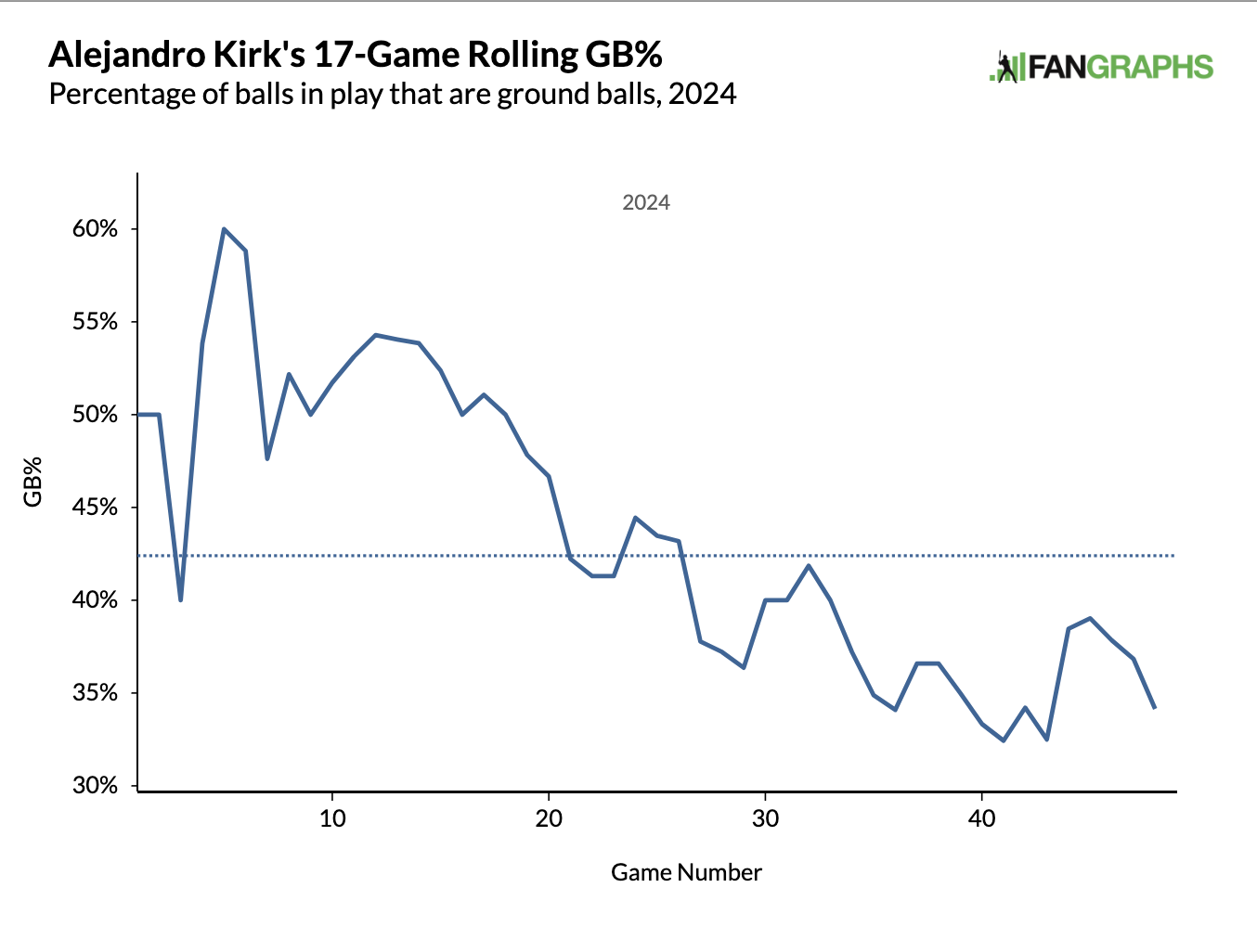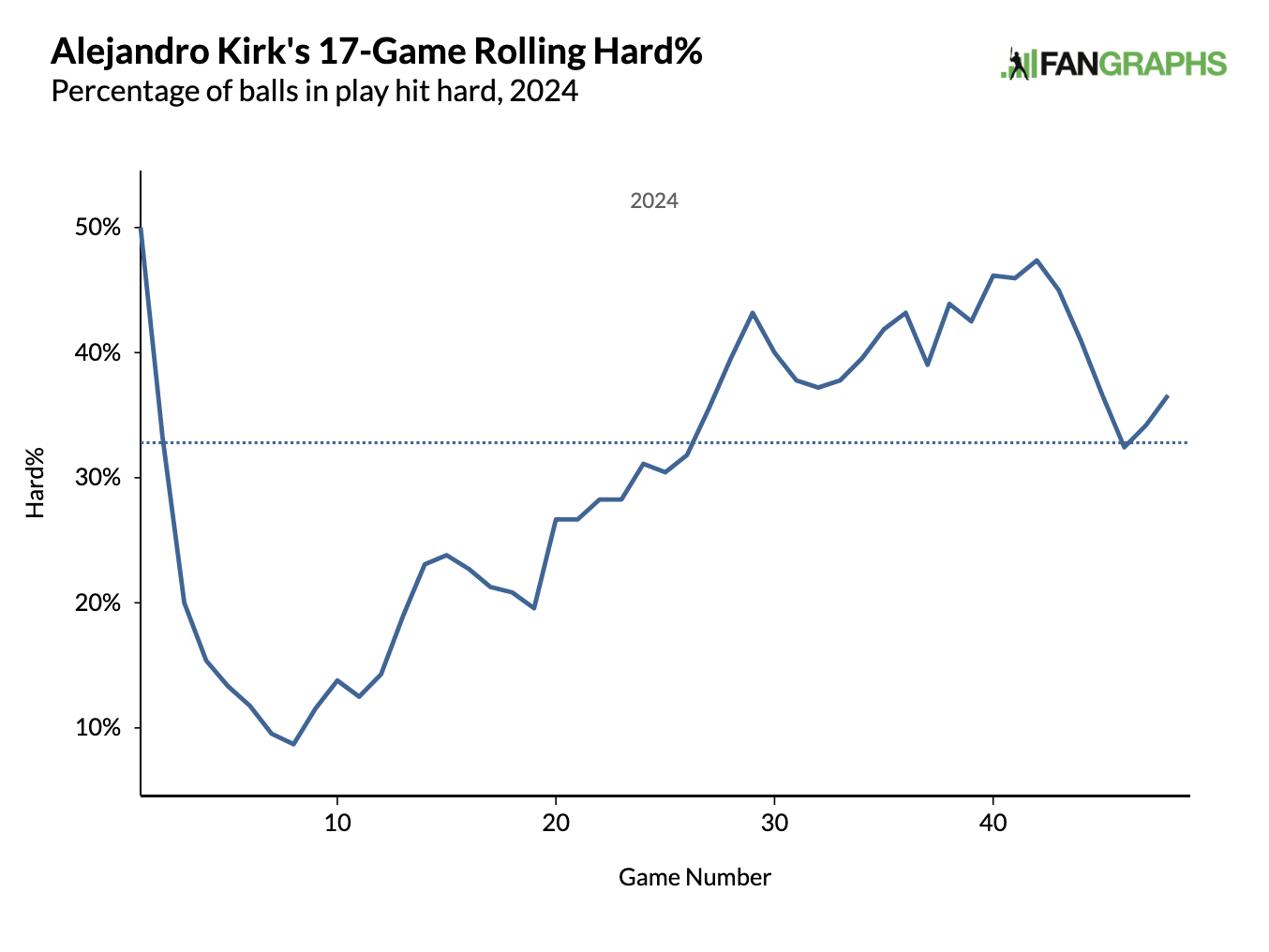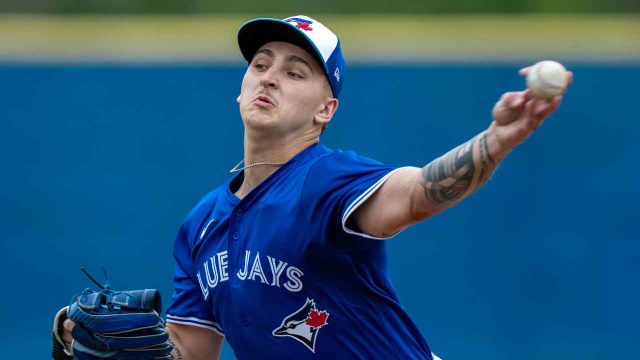
SEATTLE — For Alejandro Kirk, pre-game drill work in the batting cages is critical. He seldom takes batting practice on the field. Rather, he prefers to work directly with a Toronto Blue Jays hitting coach off a tee and high-velocity pitching machines, visualizing the ball heading straight over the pitcher’s mound off his bat.
“I don’t really like taking BP outside. Sometimes I do. But, for me, the cage work is key,” Kirk said Sunday morning after emerging from one of those lengthy sessions in the visitors’ batting tunnel at T-Mobile Park. “I focus on driving the ball to the middle of the cage. That’s a key for me. And it’s helping.”
That’s undoubtedly Kirk at his best — flat bat path, quick to the ball, balanced in his lower half, shooting line drives to all fields with triple-digit exit velocities. And that’s the Kirk who helped power the Blue Jays offence Saturday, shooting five balls to the outfield — three to right, two to left — as part of a 3-for-4 day with a sacrifice fly and two driven in. Three of the five came off his bat at 104 m.p.h. or harder. The only other Blue Jay to hit a ball that hard was George Springer.
“I loved it,” Blue Jays manager John Schneider said of Kirk’s Saturday performance. “Driving the ball. Swinging with some intent. That’s kind of the Kirky that we’ve known for a while.”
Sunday, Kirk gave Schneider two more intentful swings to love — a 107-m.p.h. sacrifice fly to right-centre in the fourth, a line drive single to left-centre leading off the seventh.
In a Blue Jays season that every day becomes more and more about evaluating what’s in place for 2025, what isn’t, and just how much needs to be added this winter, performances like Kirk’s this weekend are welcome signs. A win, 5-4 in 10 innings, and a series victory over the Seattle Mariners is another one. But only as much as it can be for an eight-games-under-.500 team that began the day with a remote, 2.4 per-cent probability of qualifying for the post-season as measured by FanGraphs.
Still, if the wins and losses are growing increasingly immaterial on a macro level, they still matter a great deal on the micro for those wearing the uniforms, including Blue Jays starter Jose Berrios, who on Sunday had another uneven day in an uneven season.
Berrios struck out a season-high 10, walked only one, and pitched into the seventh inning for the ninth time this year. But he also allowed four runs on seven hits — six of them with an exit velocity over 95 m.p.h. He worked with above-average velocity and threw 62 per cent of his pitches for strikes; but also fell behind in over half his plate appearances, hit a batter and committed a throwing error. He retired the cleanup hitter three times on seven total pitches; but allowed the No. 9 hitter to reach three times on 10.
It was a little all over the place. And it continued a trend of Berrios’ ERA increasing from month-to-month after a brilliant, AL pitcher-of-the-month April. Berrios’ biggest challenge this season has been limiting the long ball, as he entered Sunday’s start tied with Triston McKenzie for the most allowed across MLB this season at 19. And three innings in, Berrios took the lead. He was burned by — of all people — Victor Robles, who turned on an inside fastball and crushed it 424 feet to left for his first big-league homer in nearly two years.
Berrios did a good job limiting the Mariners to only that run through his first four innings, earning eight of his first 12 outs via strikeout. But Dominic Canzone led off the fifth with a liner into left-centre. And the normally sure-handed Berrios misplayed Robles’ sacrifice bunt attempt, bouncing an attempt to force the lead runner off Canzone’s helmet and into right field, putting runners on second and third.
An out later, Mitch Garver stepped into the box and helped Berrios extend his margin over McKenzie:
Meanwhile, the Blue Jays offence did its part to keep up. Robles’ third-inning homer was answered by a manufactured run in the fourth that scored on Kirk’s sacrifice fly. And Garver’s homer was erased in the seventh, when Kirk and Leo Jimenez — who collected his first two MLB hits on the day — led off with back-to-back singles before George Springer took a 98-m.p.h. Ryne Stanek heater for a 400-foot ride to the opposite field:
Ultimately, it went to extras, where the Blue Jays took the lead in the top of the 10th on Daulton Varsho’s full-count, two-out single into right, which cashed Vladimir Guerrero Jr. from second.
Then, Genesis Cabrera worked around a bases-loaded bind in the bottom half to seal a tremendously nervy victory.
Credit the Blue Jays bullpen for navigating the final four innings without allowing a run while stranding a remarkable 11 Mariners on base. Outcomes like those haven’t occurred too often for this team this season. What also hasn’t happened as often is Kirk having the Blue Jays’ hardest-hit ball of the game, as he did the last two days.
Earlier this season, Kirk made an adjustment to his pre-pitch set-up, standing closer to the plate after inadvertently drifting farther and farther away from it over the first few weeks of the season. Blue Jays assistant hitting coach Hunter Mense noticed the trend on video and brought it to Kirk’s attention, which helped the catcher cut down his whiff rate, better cover the outer third of the zone, and stay with more pitches to the opposite field.
Recently, Kirk’s been making some slight tweaks to his swing itself, cutting off his follow-through in an attempt to keep his bat path beneath pitches and minimize groundballs.
“That’s always my goal. I’m always trying to put the ball in the air and trying to eliminate those groundballs. Sometimes it works, sometimes it’s hard. But it’s always my goal,” Kirk said. “For a while there I was taking some weird swings where the timing was just not good, it was off. But right now, I feel like my timing is great. It’s getting better.”
That’s presenting itself in a couple ways. Firstly, in Kirk’s steadily declining groundball rate:
Secondly, in his steadily increasing hard-hit rate:
Kirk entered Sunday’s game with a 34.9-per-ent groundball rate since the beginning of June, and a 42.4-per-cent mark on the season. Each of the last two years he’s been at 50 per cent.
June was also Kirk’s best exit velocity month — he averaged 94.3 m.p..h on balls in play — since his MLB debut in September 2020. Of the 318 players to make at least 50 plate appearances since May 14, Kirk’s hard-hit rate ranks No. 28 — a 92nd-percentile mark.
The only thing that hasn’t followed is results. Kirk hit .167 in June with a .256 on-base percentage. It was the worst month of his career in both categories. And his .306 slugging percentage was fifth worst. For some reason, his work simply wasn’t translating. A maddening incongruity between process and results.
But Schneider has talked recently about seeing signs that Kirk’s bat is coming around. The hard-hit and groundball rates moving in opposite directions are certainly among them. And over the last two days, the line drives have started to come.
“When he’s hitting the ball hard like that, that’s when he’s really good,” Schneider said. “I think he’s just swinging with a little bit more intent. Everyone knows he can control the zone. But I think just swinging with a little bit more intent is kind of the deal.”
Whether Kirk can keep this up or not is big leverage point for the Blue Jays over the next three months. Danny Jansen’s a pending free agent — he may no longer be a Blue Jay come August. At that point, Kirk’s playing time could increase, which would be another important test of whether he can finally sustain his production while playing more often, or if his best fit is as a catcher who’s in the lineup around only three times per week.
Whether Jansen — currently the longest tenured Blue Jay — finishes the season with Toronto or not, there will remain a possibility he starts the next one elsewhere. And in that scenario the Blue Jays would need to acquire a catcher one way or another this winter, either via trade or free agency in a shallow market.
How much workload Kirk can handle, and production he can provide, will have a big say in how sizable an addition that would need to be. Just one of many determinations the Blue Jays must make between now and what’s shaping up to be a very busy winter.








